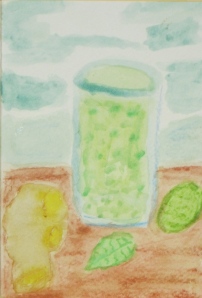
Million Dollar Bash (Self-Portrait with Johnny Harper). 12″ x 12″ watercolor pencil on paper. Sharyn Dimmick.
While many of the locals were preoccupied with the Worlds’ Series (Yay, Giants!), my sweetie got asked to play a last minute gig for a party in Oakland. Being the gentleman that he is, he asked me along to sing harmony and to wear a red dress that harmonizes nicely with his Telecaster. Saturday found us in someone’s backyard under a white cloth canopy on a temporary stage, setting up mic stands and duct taping the sign on the tip jar. The party was a reunion of sorts for some rescued pit bulls and their owners. One of the pit bulls is named Johnny Justice and we spent a certain amount of time swiveling our heads around whenever we heard people calling “Johnny.”
From where we sat on our stools onstage we could see lit Jack-o-lanterns on small tables, a bar that looked like a tiki shack, guests wearing colorful cowboy hats. A man in a red Western shirt was there to provide square dance music and calls after dark. Folding chairs and picnic tables were scattered about, along with a few hay bales. A small barn held a few of the less social pit bulls.
Bad Boy that he is, Johnny — the man, not the dog — launched into a Dylan tune called “Million Dollar Bash” after playing a few other things. He followed that with a rendition of “Pretty Boy Floyd” by Woody Guthrie, striking his blow for singing about economic justice. Demure little me sang along on both songs and was not above raising my floor length skirt for a moment to flash some leg when the lyrics called for flash. We were not asked to leave, despite such wicked antics, and, in fact, we were encouraged to have a drink and fill a plate after darkness fell. We could have square-danced, too, had we wanted to, but Johnny chose to break down gear instead and deposit the gig check in the bank.
F. Scott Fitzgerald famously said, “The rich are different from you and me.” People had driven in from Minnesota to attend the soiree. We wondered what the hosts were feeding them and wandered over to the food troughs. What we found were hot dogs and fixings: vegetarian hot dogs, sausages, hot dog buns, squeeze bottles of mayonnaise and barbecue sauce, bins of sauerkraut and dill pickles and red peppers and onions, so, once again, I was dining on a hot dog, this time with barbecue sauce, sauerkraut, red peppers and dill pickles.
The tiki bar held red wine, white wine, tiny bottles of water, warm beer in cans and several mixed drinks made in quantity in large glass jars. One, the Barn Burner, consisted of bourbon, ginger ale and apple cider, while another featured vodka, ginger ale and limes. I drank a virgin lime and ginger onstage and had the real thing later. Johnny gave me a sip of his Barn Burner, a tasty fall drink to be sure. He also gave me a cut of the take from the gig, proving once again what a good guy he is, and giving me the right to say that I get paid to sing, although, as Gillian Welch says in “Everything Is Free,” “We’re gonna do it anyway” — you can’t keep musicians from playing music, but we are really happy when you pay us and feed us to do it.
As luck would have it, we still have turkey hot dogs and sausages in our refrigerator. If hot dogs are good enough for the rich, I guess they are good enough for us to eat, too. The last time I ate hot dogs this frequently was on hot dog day in elementary school. Every Wednesday parents would gather in the auditorium of Kensington Hilltop Elementary School and boil hot dogs, place them in buns, adorn them with ketchup or mustard, or leave them plain and deliver them to each classroom. Or perhaps it was in junior high when I went through a phase of eating a hot dog, a cup of Hawaiian Punch and a package of Hostess chocolate doughnuts for lunch everyday (I survived the diet of my adolescence and your children will too, most likely). We do not, however, keep a bar stocked with vodka and bourbon — I turn vodka into homemade vanilla extract if it crosses my path and no one here drinks bourbon at all — for that, we’ll have to get invited to another private party. And, in case any rich people are listening, I would recommend upgrading the ginger ale to ginger beer — Cock’nBull brand is the best I’ve ever had.





